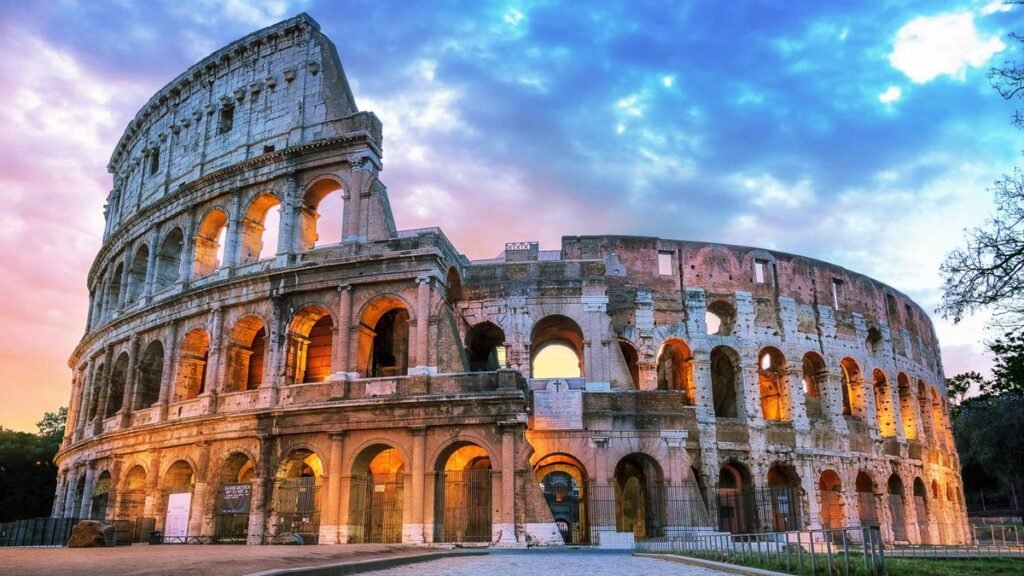
Standing as an enduring symbol of ancient Rome’s architectural prowess and cultural legacy, the Colosseum is a testament to the ingenuity, engineering mastery, and artistic vision of one of the world’s greatest civilizations. With its majestic facade, imposing presence, and rich history, the Colosseum continues to captivate visitors from around the globe, offering a glimpse into the grandeur and glory of Rome’s imperial past. In this article, we embark on a journey to explore the wonders of the Colosseum, delving into its fascinating history, architectural significance, and the timeless allure that makes it a must-visit destination for travelers seeking to immerse themselves in the ancient world.
1. A Monument to Spectacle and Entertainment
The Colosseum, also known as the Flavian Amphitheater, was commissioned by Emperor Vespasian in AD 70-72 and completed by his son Titus in AD 80. This iconic structure was designed to host gladiatorial contests, animal hunts, mock sea battles, and other public spectacles that entertained and enthralled the citizens of ancient Rome. With seating for up to 50,000 spectators, the Colosseum was the largest amphitheater of its kind in the Roman Empire, a testament to the city’s wealth, power, and cultural sophistication.
2. Architectural Marvel
The Colosseum’s architectural design is a marvel of ancient engineering and innovation, combining elements of Greek classical architecture with Roman engineering techniques to create a structure of unprecedented scale and grandeur. The elliptical shape of the amphitheater maximized seating capacity and provided unobstructed views of the arena floor, while a sophisticated system of ramps, corridors, and trapdoors facilitated the movement of gladiators, animals, and props during performances. The exterior facade, adorned with three levels of arches, columns, and decorative details, is a testament to the craftsmanship and artistic skill of the ancient Roman builders who constructed this monumental edifice.
3. Gladiatorial Combat and Public Spectacle
The Colosseum was the epicenter of gladiatorial combat in ancient Rome, where skilled fighters known as gladiators engaged in bloody battles to the cheers of the crowd. These spectacles were more than mere entertainment – they were a reflection of the values, ideals, and social hierarchies of Roman society, with gladiators embodying concepts of bravery, honor, and valor in the arena. The Colosseum also hosted elaborate reenactments of famous battles, mythological scenes, and theatrical performances, further cementing its status as a cultural and social hub of the ancient world.
4. Symbol of Roman Power and Imperial Majesty
As the largest amphitheater in the Roman Empire, the Colosseum served as a potent symbol of Rome’s military might, political dominance, and imperial majesty. Emperors and rulers used the arena as a platform to showcase their power and prestige, hosting lavish games and ceremonies that dazzled and impressed both citizens and foreign dignitaries. The Colosseum’s iconic status as a symbol of Roman greatness has endured through the ages, making it one of the most recognizable landmarks in the world and a UNESCO World Heritage Site.
5. Archaeological Wonder and Cultural Treasure
Today, the Colosseum stands as a living testament to the rich history and cultural heritage of ancient Rome, attracting millions of visitors each year who come to marvel at its architectural splendor and explore its fascinating past. Guided tours offer insights into the construction, function, and significance of the Colosseum, allowing visitors to walk in the footsteps of gladiators, emperors, and spectators who once thronged its corridors and cheered from its seats. Archaeological excavations and restoration efforts continue to uncover new discoveries and shed light on the Colosseum’s storied history, ensuring that this iconic monument remains a cherished cultural treasure for generations to come.
6. Symbol of Endurance and Resilience
Despite the passage of time and the ravages of war, earthquakes, and natural decay, the Colosseum has endured as a symbol of endurance and resilience, standing as a testament to the enduring legacy of ancient Rome. From its humble beginnings as a gladiatorial arena to its transformation into a symbol of cultural heritage and global icon, the Colosseum continues to inspire awe and wonder, reminding us of the timeless power of human creativity, innovation, and imagination.
7. Conservation and Preservation
As a cherished cultural landmark and UNESCO World Heritage Site, the Colosseum is the subject of ongoing conservation and preservation efforts aimed at safeguarding its architectural integrity and historical significance for future generations to enjoy. Measures such as structural stabilization, restoration of decorative elements, and visitor management initiatives are in place to protect the Colosseum from the effects of climate change, pollution, and wear and tear caused by mass tourism. By supporting these efforts and respecting the rules and regulations set forth by park authorities, visitors can play a role in ensuring that the Colosseum remains a symbol of ancient Rome’s grandeur and legacy for centuries to come.
Conclusion
The Colosseum stands as a testament to the ingenuity, creativity, and cultural legacy of ancient Rome, captivating visitors with its architectural splendor, historical significance, and timeless allure. Whether you’re drawn to its dramatic history, its architectural marvels, or its enduring symbolism, the Colosseum offers something for everyone to discover and explore. So pack your bags, step back in time, and embark on an unforgettable journey to the heart of ancient Rome’s grandeur and legacy at the majestic Colosseum.
